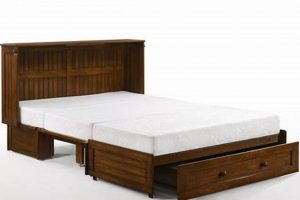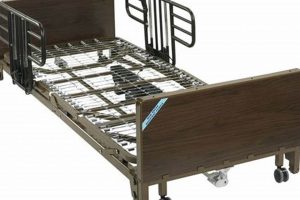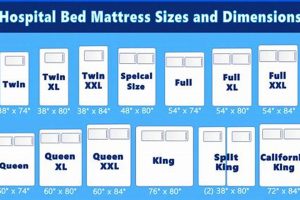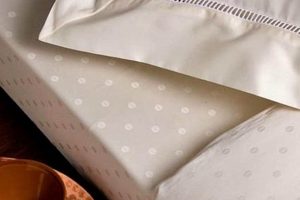Visual depictions of infestations within bedding serve as crucial diagnostic tools. These images allow individuals and professionals to identify potential problems by highlighting characteristic signs like live insects, shed skins, and fecal stains on mattresses. A clear visual reference aids in distinguishing a bed bug problem from other similar issues, ensuring appropriate and timely action.
The value of visual aids in this context stems from their accessibility and ease of understanding. Rather than relying solely on written descriptions, photographs provide immediate and concrete evidence. Historically, the use of images in pest control has proven effective in educating the public and assisting in accurate identification, leading to better management strategies and reducing unnecessary interventions. This method helps to confirm suspicions and prompts informed decisions regarding treatment.
Recognizing the importance of early detection and proper identification, subsequent sections will delve into specific visual indicators of infestation, effective inspection techniques, and proven methods for eliminating these pests. The focus will remain on providing practical knowledge to address potential infestations and maintain a healthy sleep environment.
Tips for Identifying Bed Bugs in Mattresses Using Visual Evidence
Visual confirmation of a bed bug infestation is a crucial step in effective pest management. The following tips outline key indicators to look for when inspecting mattresses using visual evidence.
Tip 1: Examine Seams and Crevices: Thoroughly inspect mattress seams, tufts, and folds. These areas provide ideal hiding places for bed bugs and their eggs. Use a flashlight to illuminate dark areas and a magnifying glass for close examination.
Tip 2: Look for Fecal Stains: Identify small, dark, rust-colored spots on the mattress surface, particularly along seams. These stains are excrement and a strong indicator of bed bug activity.
Tip 3: Detect Shed Skins: Bed bugs shed their exoskeletons as they grow. Look for translucent, light brown skins scattered near their hiding places. These shed skins are often found clustered together.
Tip 4: Identify Live Bed Bugs: Adult bed bugs are small, oval-shaped, and reddish-brown. Nymphs are smaller and lighter in color. Look for these insects during inspections, especially at night when they are most active.
Tip 5: Inspect Box Springs: The box spring is another common hiding place. Remove the dust cover and carefully inspect the interior frame for signs of bed bugs, fecal stains, and shed skins.
Tip 6: Check Headboards and Bed Frames: Bed bugs can also harbor in headboards and bed frames. Pay close attention to cracks, crevices, and joints in these structures.
Visual confirmation of bed bug evidence allows for prompt and targeted treatment, reducing the risk of widespread infestation and minimizing potential health impacts.
Effective implementation of these visual inspection tips paves the way for more informed and decisive actions in controlling these pests. The subsequent sections will address effective treatment methods and preventive measures.
1. Identification accuracy
Accurate identification of bed bugs and their signs within bedding is paramount for effective pest control. The availability of visual references, such as pictures of infestations within mattresses, directly influences the accuracy of this identification. Confusing bed bug signs with those of other pests or allergens can lead to inappropriate and ineffective treatment strategies. For instance, misinterpreting dust mite droppings as bed bug fecal stains might result in unnecessary pesticide applications, posing potential health risks and financial burdens. Bed bugs in mattress pictures provide a concrete visual benchmark, enabling individuals and professionals to correctly identify the problem.
The use of high-quality, detailed photographs showcasing different stages of bed bug life cycles (eggs, nymphs, adults) and various signs of infestation (fecal stains, shed skins, blood spots) further enhances identification accuracy. Professionals can use these resources to train staff and educate clients, while individuals can use them to verify suspected infestations. Educational campaigns utilizing clear visuals have shown demonstrable improvements in public awareness and early detection rates. In contrast, relying solely on written descriptions often leads to misdiagnosis, delaying appropriate intervention and allowing infestations to escalate.
In summary, the symbiotic relationship between accurate identification and visual aids such as bed bug images within mattresses is critical for effective pest management. The visual confirmation enhances accuracy, enabling timely and targeted interventions. While challenges exist in obtaining clear and representative images, the benefits of using such visuals in education, training, and identification are undeniable, contributing to more efficient and sustainable pest control strategies.
2. Infestation confirmation
Infestation confirmation, in the context of potential bed bug problems, hinges significantly on definitive evidence. Visual documentation, specifically images of bed bugs within mattresses, often serves as a critical component in this confirmation process. The presence of observable evidence directly impacts the certainty and subsequent actions taken.
- Direct Observation of Bed Bugs
The most compelling confirmation arises from directly observing live bed bugs on or within the mattress. High-resolution images capturing the insects themselves, particularly adults and nymphs, provide unequivocal proof of an infestation. These visuals eliminate ambiguity and are often required by pest control professionals before initiating treatment. Lack of such direct observation may necessitate further investigation or reliance on secondary indicators.
- Identification of Fecal Stains
Fecal stains, characterized as small, dark, rust-colored spots, are indicative of bed bug activity. Mattress pictures showcasing these stains along seams, tufts, or other crevices offer valuable confirmation. However, differentiating these stains from other types of discoloration or soiling is crucial. Images with detailed close-ups and comparisons to reference samples aid in accurate identification, preventing misdiagnosis and inappropriate interventions.
- Detection of Shed Skins and Eggs
As bed bugs mature, they shed their exoskeletons, leaving behind translucent skins. Similarly, the presence of small, oval-shaped eggs attached to mattress fibers can confirm an infestation. Pictures highlighting these remnants provide supplementary evidence, especially when live bugs are not immediately apparent. The
density and distribution of shed skins and eggs can also offer insights into the duration and severity of the infestation. - Pattern Recognition and Distribution
Images can reveal patterns of infestation, such as concentrated areas of activity along seams or near the head of the bed. The spatial distribution of bed bugs, fecal stains, and shed skins can further solidify confirmation. Uniform dispersion might suggest a more established and widespread infestation, while localized clusters may indicate a recent or contained problem. This visual assessment aids in tailoring treatment strategies to effectively target affected areas.
These facets underscore the crucial role visual documentation plays in confirming infestations. The presence and accurate interpretation of observable evidence within mattress pictures guide decision-making processes, inform treatment strategies, and contribute to effective pest management. The ability to visually confirm infestations reduces reliance on circumstantial evidence and minimizes the risk of unnecessary or ineffective interventions.
3. Damage assessment
Damage assessment in the context of infestations involves evaluating the physical and economic consequences resulting from the presence of these pests. Visual documentation, specifically pictures of bed bugs within mattresses, plays a critical role in quantifying and characterizing this damage.
- Mattress Degradation
Repeated infestations can lead to physical deterioration of the mattress. Visual evidence, such as photographs, can document staining from fecal matter, blood spots, and the physical presence of shed skins and dead bed bugs. These contaminants can compromise the integrity of mattress materials, potentially reducing its lifespan and necessitating premature replacement. Severity of degradation directly correlates with the duration and intensity of the infestation, demonstrable through comparative imagery over time.
- Allergenic Contamination
Bed bugs and their byproducts can act as allergens, triggering allergic reactions in susceptible individuals. Pictures illustrating the concentration of fecal matter and shed skins can indirectly assess the potential for allergenic contamination. The higher the visible concentration of these materials, the greater the likelihood of triggering respiratory or dermal allergic responses. Damage assessment, in this case, extends beyond physical deterioration to encompass potential health impacts.
- Economic Impact
Visual evidence contributes to determining the economic ramifications of infestations. Images documenting extensive staining and degradation provide justification for mattress replacement claims with insurance providers. Furthermore, such documentation is essential in legal disputes between tenants and landlords regarding responsibility for remediation costs. Photographic evidence serves as tangible proof of the level of damage, influencing financial settlements and liability determinations.
- Psychological Distress
The presence of bed bugs can induce significant psychological stress and anxiety. Images serve as a constant reminder of the infestation, exacerbating feelings of unease and impacting sleep quality. Although psychological damage is inherently subjective, visual evidence of widespread infestation can corroborate claims of emotional distress in legal or insurance contexts. The aesthetic damage captured in photographs contributes to the overall assessment of harm.
In conclusion, pictures of bed bugs within mattresses are not merely diagnostic tools; they are crucial components in a comprehensive damage assessment. These visuals provide concrete evidence of physical degradation, allergenic contamination, economic impact, and psychological distress, enabling a more thorough understanding of the consequences resulting from infestations. This comprehensive approach to damage assessment informs remediation strategies and contributes to effective resolution of infestation-related issues.
4. Source pinpointing
Accurately identifying the origin or primary harborage of infestations within bedding is fundamental to successful remediation efforts. Visual documentation, specifically photographs of bed bugs within mattresses, significantly aids in this crucial process, enabling targeted treatment and preventing recurrence.
- Seam and Crevice Identification
Mattress seams, tufts, and crevices often serve as initial or primary hiding places. Detailed images highlighting bed bugs clustered within these areas provide direct evidence of their harborage preference. This localized identification allows for focused insecticide application or steam treatment, minimizing unnecessary exposure of the entire mattress surface. For example, photographs revealing a dense population within a specific seam segment guide precise intervention, reducing the scope of treatment and associated costs.
- Proximity to Sleeping Areas
Visuals can demonstrate the proximity of harborage points to areas of human contact. Images showing bed bugs concentrated near the head or upper portion of the mattress strongly suggest that these locations serve as primary feeding grounds. This information informs strategies such as encasing the mattress or implementing targeted barrier treatments around the sleeping area. Understanding the relationship between harborage location and human activity patterns is crucial for effective source elimination.
- Evidence of Egg Clusters
The presence of egg clusters is a strong indicator of a long-term or recurring infestation. Photographs documenting these clusters, typically found in protected areas within the mattress, pinpoint breeding sites. These sites warrant specific attention during treatment, as insecticide resistance may be higher in established populations. Identifying and targeting egg-laying locations is essential for preventing future generations and achieving complete eradication.
- Association with Structural Defects
Mattress damage, such as tears, punctures, or compressed padding, can create ideal hiding places. Images highlighting bed bugs residing within these structural defects allow for targeted repair or replacement decisions. Furthermore, such defects may serve as entry points for bed bugs originating from nearby furniture or structural components. Addressing both the bed bug harborage and the underlying structural vulnerability is critical for long-term prevention.
These facets illustrate how visual evidence contributes to precise source pinpointing in bed bug infestations. By leveraging detailed photographs of mattress interiors and surfaces, pest control professionals and homeowners alike can implement targeted and effective remediation strategies. This precision minimizes chemical exposure, reduces treatment costs, and enhances the likelihood of complete eradication, ultimately fostering healthier and more comfortable living environments.
5. Treatment effectiveness
Visual documentation of infestations before
and after treatment serves as a crucial metric in determining the success of pest control interventions. The presence of bed bugs, fecal stains, shed skins, and eggs captured in pre-treatment photographs provides a baseline against which to assess the efficacy of implemented strategies. Reduction or elimination of these visual indicators in post-treatment images directly correlates with the effectiveness of the chosen method, whether it involves chemical applications, heat treatments, or other strategies. Failure to achieve a noticeable reduction in visual evidence suggests the treatment was insufficient, potentially due to resistance, improper application, or overlooked harborage sites. In such cases, alternative strategies or repeat treatments may be necessary.
Images also enable a granular evaluation of treatment effectiveness. For example, comparisons of pre- and post-treatment photographs of mattress seams and crevices can reveal whether targeted insecticide applications successfully penetrated these areas, eliminating bed bugs and their eggs. Similarly, documenting the presence or absence of fecal stains post-treatment indicates whether residual insecticide continues to control newly hatched nymphs. This detailed analysis guides optimization of treatment protocols and ensures long-term control. Consider a scenario where heat treatment is applied to a mattress, and post-treatment images reveal live bed bugs in the inner layers, indicating insufficient heat penetration. This feedback prompts adjustments to the treatment parameters, such as increasing the exposure time or temperature, to achieve complete eradication.
The objective evaluation of visual evidence is critical for informed decision-making in pest management. While the absence of visual evidence does not guarantee complete eradication, it provides a tangible indicator of progress and guides subsequent actions. Accurate interpretation of images, coupled with ongoing monitoring, helps ensure that treatments are effective, sustainable, and minimize unnecessary chemical exposure. Furthermore, photographic documentation serves as a valuable record for pest control professionals and homeowners, facilitating communication, tracking treatment progress, and resolving potential disputes.
6. Prevention guidance
Prevention guidance, when informed by photographic evidence of infestations within mattresses, offers a targeted approach to minimizing risks. Visual data from “bed bugs in mattress pictures” directly illuminates vulnerable areas and infestation patterns. For example, if images consistently reveal concentrations along seams, prevention efforts can emphasize meticulous seam inspections and targeted protective measures. The link between visual evidence and prevention guidance is therefore causal: observable patterns inform proactive interventions. Effective guidance requires an understanding of entry points and harborage locations, and “bed bugs in mattress pictures” provide crucial insights into these aspects.
The practical significance of this understanding is substantial. Consider a scenario where a traveler routinely stays in hotels. Prevention guidance informed by visual data would prompt meticulous inspection of mattresses, particularly seams and headboards, for any signs of infestation. Early detection, guided by an awareness of visual indicators, enables prompt action, such as requesting a different room or taking precautions to prevent transporting the pests. Similarly, individuals purchasing used furniture can leverage visual guidance to identify potential risks before introducing infested items into their homes. The capacity to preemptively address potential issues drastically reduces the likelihood of full-scale infestations.
In conclusion, prevention guidance significantly benefits from the actionable insights gleaned from photographic documentation. While challenges remain in generating universally representative images and maintaining public awareness, the connection between visual evidence and targeted prevention strategies is undeniable. “Bed bugs in mattress pictures” facilitate informed decisions, minimize risks, and promote proactive approaches to pest management, contributing to healthier and more comfortable living environments.
7. Educational resource
The utility of “bed bugs in mattress pictures” as an educational resource lies in its capacity to convey complex information concisely and memorably. A visual representation bypasses potential ambiguities inherent in written descriptions, enabling individuals to rapidly identify signs of infestation. This immediacy is particularly crucial for those lacking prior knowledge or experience with pest identification. The resource effectively serves as a primer, democratizing access to essential information and empowering proactive engagement in pest management.
Consider a scenario in which a community health organization seeks to educate residents in underserved areas about bed bug prevention and identification. Distributing pamphlets with detailed photographs of infestations within mattresses enables residents to recognize potential problems in their own homes, regardless of literacy levels or language barriers. This visual approach is far more effective than relying solely on textual materials, leading to earlier detection, prompt intervention, and reduced health risks. Additionally, pest control companies often utilize these images in training new technicians, ensuring consistent and accurate identification practices. These visuals serve as a standard reference, promoting quality control and minimizing diagnostic errors.
In conclusion, “bed bugs in mattress pictures” are valuable educational resources, effectively conveying complex information and empowering individuals to take proactive steps in pest management. Although access to high-quality images and accurate interpretation remain ongoing challenges, the potential benefits of visual education in promoting early detection, minimizing health risks, and improving overall pest control outcomes are undeniable.
Frequently Asked Questions about Bed Bugs in Mattress Pictures
The following addresses frequently asked questions regarding the use and interpretation of visual documentation relating to infestations within bedding.
Question 1: Why is visual confirmation necessary to determine an infestation?
Visual confirmation provides tangible evidence that supplements circumstantial indicators, such as bites or unexplained skin irritation. Images of live bed bugs, fecal stains, or shed skins offer definitive proof, guiding appropriate intervention strategies.
Question 2: How can I distinguish bed bug fecal stains from other types of stains on a mattress?
Bed bug fecal stains typically appear as small, dark, rust-colored spots. They often occur in clusters along seams and crevices. Other stains may exhibit different colors, patterns, or textures, necessitating careful examination.
Question 3: What is the best way to take effective pictures of bed bugs within a mattress?
Employ a high-resolution camera or smartphone with a macro lens. Ensure adequate lighting and focus on key areas such as seams, tufts, and crevices. Capture images of live bed bugs, fecal stains, and shed skins for comprehensive documentation.
Question 4: Can bed bugs live inside the mattress, or only on the surface?
Bed bugs commonly reside within the mattress, particularly in seams, crevices, and under labels. They may also harbor in box springs, bed frames, and nearby furniture. Thorough inspection of all potential hiding places is essential.
Question 5: What does it mean if bed bug pictures show only shed skins and no live bugs?
The presence of shed skins indicates past or ongoing bed bug activity. While the absence of live bugs suggests the infestation may be controlled, continued monitoring is recommended to ensure complete eradication. Shed skins can persist long after active infestation ceases.
Question 6: Are all stains visible on mattress pictures indicative of an infestation?
Not all stains definitively indicate bed bug activity. Some may be due to spills, mold, or other contaminants. Careful examination and comparison to known bed bug indicators are necessary for accurate identification. If uncertain, consulting a pest control professional is advisable.
Accurate identification and interpretation of visual evidence are crucial in effective pest management.
The following section will detail methods of treatment and prevention for pest infestations.
Conclusion
The examination of “bed bugs in mattress pictures” reveals a critical intersection between visual documentation and effective pest management. This resource’s value spans from accurate identification to the assessment of treatment effectiveness, highlighting its multi-faceted significance in controlling these pests. The clarity and accessibility of visual information contribute directly to informed decision-making and targeted interventions.
Given the proven utility of “bed bugs in mattress pictures,” continued investment in high-quality visual resources and public education initiatives is warranted. The capacity to recognize and address these infestations promptly remains essential in safeguarding public health and ensuring comfortable living environments. Vigilance, informed by visual evidence, is paramount for effective and sustained control.





![Best Air Bed Double Mattress [Deals] For Comfy Nights! Organic & Natural Mattress Buyer’s Guide: Non-Toxic Sleep Solutions Best Air Bed Double Mattress [Deals] For Comfy Nights! | Organic & Natural Mattress Buyer’s Guide: Non-Toxic Sleep Solutions](https://mattressworldpa.com/wp-content/uploads/2025/07/th-7086-300x200.jpg)

